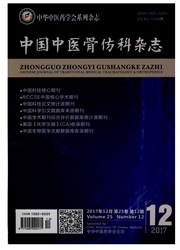

 中文摘要:
中文摘要:
目的:观察膝骨性关节炎患者膝关节红外热像特征,分析其对膝关节痛点的反映情况。方法:选取病房及门诊患者中符合膝关节骨性关节炎诊断的患者60例,进行膝关节部位红外热成像检查,测量病变疼痛膝关节与无症状膝关节相关区域的温度,并与10位健康无膝关节疾病受试者及与膝骨性关节炎年龄相仿的无膝关节疾病的30位受试者,进行膝关节相关区域温度对比,观察膝关节骨性关节炎的红外热像表现。对膝关节骨性关节炎就诊的患者膝关节压痛点进行记录,将压痛点分布情况与红外热像结果进行对照。结果:88例表现出关节炎症状的膝关节红外热像温度与同年龄段无膝关节疾病受试者比较温度升高,但是比健康青年人膝关节热像温度低。红外热像检查能够反映出内外侧膝眼、髌上囊、鹅足囊等压痛点较明确的痛点。结论:红外热像检查可明确反映膝关节疼痛部位;急性膝关节疼痛出现时红外热像温度较同年龄无症状膝关节温度升高;但患有膝骨性关节炎患者膝关节局部温度较无膝关节疾患的青年人温度低,临床参考时应结合红外热像与临床查体,辨证使用,分清虚实。
 英文摘要:
英文摘要:
Objective:To analyze the characteristics of infrared thermal imaging in patients with KOA,and to observe its sensitivity of knee tenderness point.Methods:60patients with KOA were selected in the ward and clinic,and the infrared thermal imaging examination was performed to measure the temperature of the knee joint and the related area of the asymptomatic knee joint.Also they are compared in the related area with other 10 healthy subjects and 30age-matched patients without knee disease,and the infrared thermal imaging were observed.The knee joint tenderness points were recorded in patients with KOA,and the distribution of tenderness points was compared with the results of infrared thermal imaging.Results:The infrared thermal imaging temperature of 88 patients with arthritis symptoms was higher than that of subjects without knee disease in the same age group,but it was lower than that of normal healthy young people.Infrared thermal imaging can clearly point out the tenderness points such as medial and lateral XIYAN,suprapatellar bursa and pes anserinus bursa.Conclusion:Infrared imaging examination can confirm the knee tenderness point.The infrared thermal imaging temperature in patients with acute arthritis symptoms was higher than that in the same age group without acute arthritis symptoms,but it was lower than that of healthy young people.The clinical application should be combined with infrared thermography,clinical examination and diagnosis,and distinguish the actual situation.
 同期刊论文项目
同期刊论文项目
 同项目期刊论文
同项目期刊论文
 期刊信息
期刊信息
